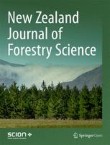Prior research in 2005 and 2008 estimated planted forest investment returns for a set of countries and included some natural forest species in a few countries. This research has extended those analyses to a la...
Authors:
Frederick Cubbage, Patricio Mac Donagh, Gustavo Balmelli, Virginia Morales Olmos, Adriana Bussoni, Rafael Rubilar, Rafael De La Torre, Roger Lord, Jin Huang, Vitor Afonso Hoeflich, Mauro Murara, Bruno Kanieski, Peter Hall, Richard Yao, Paul Adams, Heyns Kotze…
Citation:
New Zealand Journal of Forestry Science
2014
44(Suppl 1):S7
Content type: Proceedings
Published on: 26 November 2014
